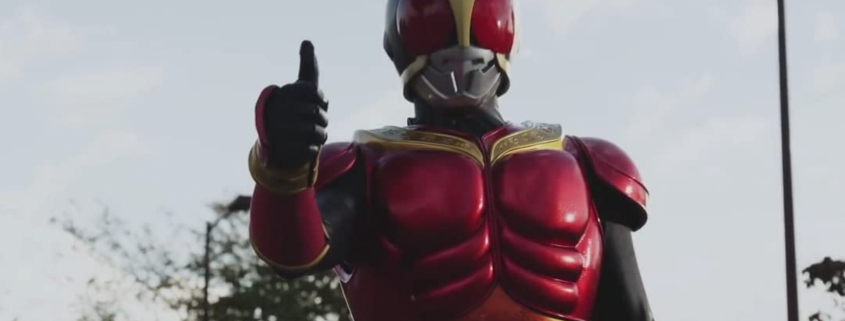Stardust: Combating violence in ‘Kamen Rider Kuuga’

For some background,“Kamen Rider Kuuga” is a Japanese Tokusatsu show featuring superheroes and special effects, and is one of the first installments of the series in the Hesei Era of Japan (The Heisei era is the period of Japanese history corresponding to the reign of Emperor Akihito from Jan. 8, 1989 until his abdication April 30, 2019). The Toei Company produced the show in 2000 but released it in the United States just last year in May 2020.
I recently decided to look back to this old show to appreciate the themes found within its story. With 49 episodes and a short running time of 20 minutes for each, only some of the main plot points will be reviewed below to emphasize the theme of fighting for others’ happiness rather than simply the happiness of oneself. Episodes of this show can be found on YouTube and on the ShoutFactoryTV site.
“Kamen Rider Kuuga” revolves around the hero, Kuuga, fighting monsters known as the Grongi. They are, in reality, an ancient tribe of people that terrorized the ancestors of modern-day humans in the show’s universe. They end up returning after being sealed away by the ancient warrior Kuuga.
Some of the main characters who try to help stop the Grongi consist of Godai Yusuke, aka the new Kamen Rider Kuuga, and Kaoru Ichijo, an officer of the Science Police force who works with Kuuga. Some of the main antagonists include N-Daguva, the strongest of the Grongi, and Ra-Baruba-De, the judge of the Grongi’s “game.” This lethal game developed by the Grongi is the central conflict of the series as it showcases the pain that can be inflicted on others when fighting for happiness.
Starting with Ichijo, he experiences the distorted views of the villains first-hand when working with his fellow officers to fight an invisible Grongi in episode 22, “Game.” The Grongi describes his happiness with killing people, stating that it’s “fun.” In the same episode, Ichijo encounters one of the leaders of the Grongi, Ra-Baruba-De, who states that the humans they faced long ago have now changed. This is explained later in the series with how humanity is still fighting with one another even without the Grongi, despite the fact the Grongi were defeated to avoid such violence. Thus, the show does well in setting up ideas such as, “If violence is needed to stop violence, how does it stop?”
This connects to the main protagonist, Godai Yusuke, who is a carefree individual who can be considered a paragon character (a type of hero that is regarded as the “ultimate” champion of concepts, such as truth, justice and honor) in regards to fighting for the smiles of others — making certain that later events are even more impactful.
Such events include episode 35, “Emotion,” where Yusuke fights a Grongi hunting and hurting school kids for fun. Yusuke, aka Kuuga, becomes overcome by rage at the number of people he hasn’t been able to save from the previous episodes. Pushed by the fears of the student he is trying to guard, Godai fights against this Grongi.
Not letting up, Kuuga continues punching the Grongi and uses a large amount of his arsenal against him. The music becomes eerie, indicating that Kuuga is now the hunter but at the same time emphasizes the emotional pain Godai feels. This scene highlights how the powers of Kuuga can go either way — as a light or a threat to his own happiness.
In episode 41, “Control,” there is further emphasis on how Yusuke doesn’t enjoy hurting others, despite his similar powers to the Grongi. Even though each fight makes him stronger, by helping him achieve new evolutions and gain new weapons, the changes on his body are a growing concern for his friends. His body is healing faster, and his friends’ concerns about the future are actually a set up for the dangerous powers he would soon obtain, putting his own humanity to the challenge, as witnessed from a vision in episode 35, where he is shown as an “ultimate warrior.”
However, in this episode, when one of Yusuke’s friends has vengeful thoughts on someone, he states:
“Well, that just shows you’re human.”
Thus, Godai is aware he can’t always forget about those violent thoughts but instead strives to avoid escalating the problem, even when he believes he is in the right: fighting evil. This mindset contributes to the theme of striving to fight for others rather than not caring about the consequences of one’s actions like the Grongi. This all comes to a conclusion in Yusuke’s battle with N Daguva, the series’s main antagonist.
To defeat Daguva, Yusuke has to become an “ultimate warrior,” taking on a role that contrasts his personality. Ichijo, who is by Yusuke’s side before the fight, states he didn’t want to see Yusuke go down this path, but Yusuke, following the show’s theme, stays true to himself.
Yusuke states he made the right choice and was glad to meet Ichijo. This scene involves parallels from episode 1 as Yusuke asks Ichijo to watch his transformation yet again. This bears great contrast to Daguva, who constantly laughs from enjoyment regarding the Grongi’s game and the destruction he causes for others.
Daguva is also glad that Yusuke obtained powers similar to him, but Yusuke eventually survives with his mind still intact. Yusuke’s journey through his evolutions helps emphasize how using violence for one’s happiness should not overtake the happiness obtained from other people.
Overall, “Kuuga” does a nice job expressing how there are both similarities and contrasts between the main characters and the villains when fighting for happiness. Nevertheless, there is still the important theme of striving toward peace despite the presence of harsh reality.

